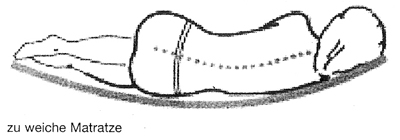The basic requirement for the mattress is that it gives the user the freedom to sleep in any position they choose. It must support the user in all sleeping positions on the back, stomach and side, without forcing a particular position due to its design. Point elasticity: The mattress should only give way where it is stressed, but not in a wider area. A good mattress conforms to the shape of the body and supports the whole body evenly. Oscillation behavior: The mattress should only bounce briefly after every movement, so that the sleeper does not have to actively stabilize his posture. This is important because we change sleeping position 30-50 times a night. The fewer oscillations the mattress has, the better (more comfortable). Moisture regulating: Around 0.5 to 1 liter of liquid, waste products, salts and toxins evaporate through the skin every night and some of them get into the mattress and bed linen. This moisture must be quickly transported away into the room air in order to maintain a pleasant bed climate. A bed that is too humid not only causes an unpleasant feeling, it also promotes rheumatism. The mattress must therefore not provoke excessive sweating and must draw the resulting body moisture away from the body, thus providing a wonderfully pleasant, dry sleeping environment.
Service life
The service life of a good mattress is designed to be around 7-10 years. The main reasons against longer use are hygiene reasons, but also the sleeping comfort, which decreases with increasing service life, as even the best upholstery materials wear out over time.
Degree of hardness
All mattresses are basically suitable for every body weight. As a rule, however, a heavy person will prefer a mattress with a degree of hardness of 2 or even 3. However, a fixed rule or table cannot be established, as the decisive individual perception is very different. Whether a soft or hard mattress is preferable can therefore be left to personal taste, apart from extremes.
A mattress that is too soft or saggy
You change your position 30 to 50 times while you sleep. A mattress that is too soft or saggy reduces the necessary change in position. The desired regeneration of the spine, intervertebral discs and muscles is not achieved. The spine sags like in a hammock.

Too hard a surface
The spine becomes cramped and bent. When lying on your side, the shoulders and pelvis are pushed upwards. The individual parts of the body are supported. Shoulders and hips can sink in more when lying on your side. In the anatomically correct resting position, the spine and torso muscles are relaxed. The slightly S-shaped spine must be supported and supported in its natural shape.

Just come by and we’ll explain the differences to you. Both in terms of the different materials and which type of mattress is right for you. Custom-made mattresses are also no problem. Because: you shouldn’t adapt to the mattress, the mattress should adapt to you!

